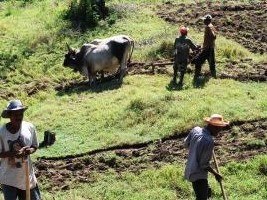|
||||||||||||||||||
|
|
Haiti - Agriculture : The autumn harvests are underperforming 05/01/2020 08:25:30
With the resumption of economic activities, disrupted for several months, a regular supply of the markets is observed, except in Croix-des-Bossales and Gonaïves. However, the situation remains unpredictable and is likely to deteriorate as the root causes of the current crisis have not been addressed. The price of food products remains significantly above average. Migration, the sale of coal, among others, will constitute sources of income for the poor and very poor until the start of the spring campaign, the winter campaign not being important in terms of labor supply." Looking ahead to May 2020, Fews Net analysts maintain their forecasts and remain cautious about the situation in Haiti explaining "The development of the current situation largely reflecting the assumptions made in the outlook for October 2019 to May 2020, the same assumptions can be made. Despite the recent resumption of economic activities and an apparent return to calm, there is no evidence to conclude that the situation has stabilized in the long term and that the socio-political unrest will last until to May 2020 is maintained." They specify that the harvests of the autumn campaign temporarily improve the food availability for certain households, "but in a limited way for the regions which are the subject of a significant vulnerability to food insecurity in made of chronic factors (higher poverty rates, difficult access to markets), or who did not benefit from sufficient rainfall and who suffered crop losses have lower food availability [...] In addition, many households are still experiencing the effects of socio-political disturbances, even if the situation has been improving for a few weeks. Many areas are therefore expected to remain in Stress (IPC Phase 2) and Crisis (IPC Phase 3) until January 2020. The second period of the scenario coincides with the peak of the winter crops, which are not important in terms of volume and which are dominated by the bean in irrigated plains and humid mountains as well as by the Congo pea, then by some roots and tubers , bananas and the launch of the spring 2020 campaign. Once the stocks of winter and fall crops are used up, households will have to get supplies from the market. Non-agricultural sources of income could be disrupted by socio-political unrest. This added to the high level of commodity prices could decrease the purchasing power of households. Thus, the poorest households should still have recourse to crisis strategies such as the intensification of the sale of charcoal, the consumption of low quality food or the reduction in the number of daily meals. This would help to amplify the erosion of livelihoods. In this context, the number of food crisis zones (IPC Phase 3) could increase. Learn more about the Integrated Food Security Phase Classification (IPC) : Phase 1 : Usually adequate and stable food access with moderate to low risk of sliding into Phase 3, 4, or 5. Phase 2 : Moderately / Borderline Food Insecure Borderline adequate food access with recurrent high risk (due to probable hazard events and high vulnerability) of sliding into Phase 3, 4, or 5. Phase 3 : Acute Food and Livelihood Crisis Highly stressed and critical lack of food access with high and above usual malnutrition and accelerated depletion of livelihood assets that, if continued, will slide the population into Phase 4 or 5 and / or likely result in chronic poverty. Phase 4 : Humanitarian Emergency Severe lack of food access with excess mortality, very high and increasing malnutrition, and irreversible livelihood asset stripping. Phase 5 : Famine / Humanitarian Catastrophe Extreme social upheaval with complete lack of food access and / or other basic needs where mass starvation, death, and displacement are evident. SL/ HaitiLibre
|
|
|
Why HaitiLibre ? |
Contact us |
Français
Copyright © 2010 - 2024 Haitilibre.com |



